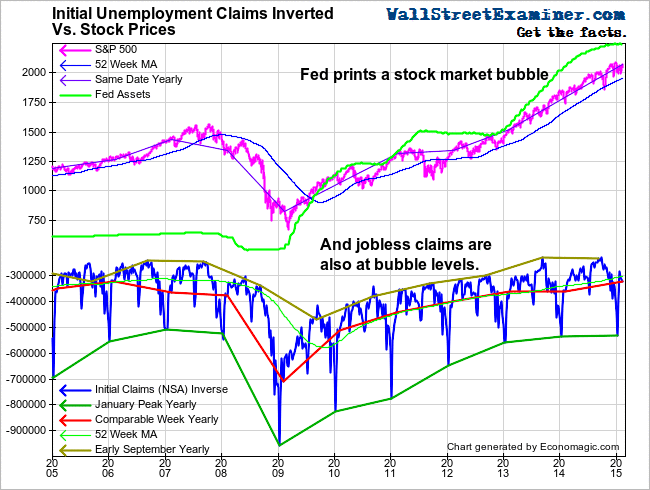The headline, fictional, seasonally adjusted (SA) number of initial unemployment claims for last week came in at 304,000. The Wall Street conomist consensus guess was 285,000.
Rather than playing the expectations game, our interest is in the actual, unmanipulated data. Analyzing that is the only way to be sure that you are seeing what’s really going on. The Department of Labor reports the actual unadjusted data clearly and illustrates it in comparison with the previous year. The mainstream financial media ignores that data, obscuring what the trend is actually doing.
According to the Department of Labor the actual, unmanipulated numbers were as follows. “The advance number of actual initial claims under state programs, unadjusted, totaled 323,672 in the week ending February 7, an increase of 17,061 (or 5.6 percent) from the previous week. The seasonal factors had expected a decrease of 9,215 (or -3.0 percent) from the previous week. There were 360,338 initial claims in the comparable week in 2014.”
This year’s performance was worse than average for the first week of February. The actual week to week change was an increase of 17,000 (rounded). The 10 year average for that week is a decrease of -6,000 (rounded). This year’s increase compared with a an increase of 3,000 in the comparable week of 2014, and a decrease of 27,000 in that week of 2013.
Week to week changes are volatile and one bad week does not make a trend. Looking at the momentum of change over the longer term, actual first time claims were 10% lower than the same week a year ago. This is within the normal range of the annual rate of change. Since 2010 the change rate has mostly fluctuated between -5% and -15%. There is no sign of the trend weakening yet.
The data indicates that employers are hoarding workers. Businesses have been unusually reluctant to cut employees. In fact, initial claims are at all time record lows in terms of the number of claims per million workers. Is that a sign of a healthy, growing economy, or a bubble economy stretched to the limit? The last two times these numbers were nearly as strong were at the tops of the housing bubble and the internet/tech bubble.The current numbers suggest bubble like behavior, indicative of the excessive optimism that characterizes the end stages of economic booms and bubbles.
This come on the heels of the long running US oil/gas bubble, which peaked in the middle of last year and has since collapsed. While most states show the level of initial claims well below the levels of a year ago, in the oil producing states of Texas, North Dakota, and Louisiana, claims are now above year ago levels (state data January 31 week). North Dakota claims first increased above the year ago level in early November. Louisiana reversed in mid November. But as recently as mid January, claims in Texas were still lower than the year before. With its huge and widely diversified economy, Texas could be the harbinger of things to come for the entire nation as the ripple effects of the oil collapse and the disappearance of those $85,000 per year jobs spread through the US economy.
I track the daily real time Federal Withholding Tax data in the Wall Street Examiner Professional Edition. The growth rate of withholding taxes is now running at an annual rate of gain of about 6.5% in real terms, adjusted for the trend rate of increase in workers’ weekly incomes. This is a record growth rate. It has the feel of as good as it gets.
The big actors in the economy are partying like it’s 1999. The tech bubble topped out in 2000 and the recession followed. Recall too that the housing bubble peaked in 2006, but the damage did not begin to scare businessmen, policy makers,Wall Street and mainstream pundits until late 2007, and the real collapse followed a year later.
While we have been teased with signs of change in the claims data from time to time, the trend is still in force. Only if we start to see the numbers coming in above the year ago comparable week for a few weeks would it be a sign of material change in trend, and a possible excuse for the Fed to bring back the Ghost of QE Past. There are hints that that’s coming, but unless the gross numbers break soon, the data will encourage the Fed to start the smoke and mirrors game of pretending to raise interest rates.




